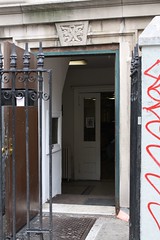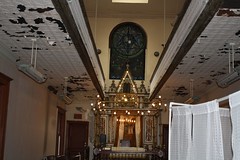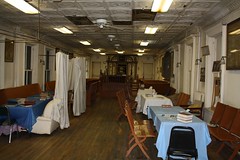Workers started moving furniture out of Anshei Meseritz Synagogue this week, after the Landmarks Preservation Commission approved a plan to add a penthouse to the historic building on East Sixth Street. The Local recently got what may well be a last look at the synagogue before its conversion into apartments.
After years of trying to find a developer, Meseritz’s board leased the building to East River Partners LLC in a deal worth about $1,225,000, as reported in DNAinfo. The building’s facade is protected as part of the East Village/Lower East Side Historic District, but the deal allows the developers to convert the inside of the synagogue into luxury condos provided they invest $180,000 to accommodate the congregation in the basement.
“The issue for us is how do we preserve the synagogue as a vibrant, growing part of the neighborhood?” said Charles Knapp, a lawyer for the synagogue.
The Local reported earlier this month that some community members are unhappy with the terms of the lease, and feel that Meseritz’s board didn’t solicit enough input when devising the plans. But Mr. Knapp said the only alternative to the redevelopment was further decay. “We can’t let perfect be an enemy of good,” he told The Local.
During our recent tour of Meseritz, it was clear the building was in a state of disrepair. Plaster was crumbling from the ceiling, the paint on most surfaces was peeling off, and many of the benches for congregants to sit on were broken. In addition, some the stained glass that gives the building its signature look had shattered, leaving multiple holes in the windows.
“Most of the people are well meaning, but they don’t appreciate the dire straits that the the synagogue is in,” Mr. Knapp said. He added that it would cost approximately $100,000 to fix the roof alone, money that most developers weren’t interested in investing.
“We’re here to stay, so we need new bricks, new pipe, wheelchair access, and we are going to have it,” said Sandy Ackerman, son of the synagogue’s long time rabbi, Pesach Ackerman. “We are going to have a place for another 100 years, and that’s what’s important. It will be self-sustaining,” he added.
According to Mr. Knapp, none of the feasible development deals would be able to preserve the synagogue’s main sanctuary on the first floor, which features a carved wooden ark built in 1910 and plaques from the founding families on the walls. Rabbi Ackerman and Robert Rand, the president of the congregation, are doing what they can to save the fixtures from the synagogue’s early days, Mr. Knapp said.
The ark, for example, will be painstakingly removed next week and put into storage so it can eventually be transferred to a new synagogue in Tribeca.
“Part of what we are doing with the new synagogue is reclaiming past traditions and giving them new life,” said Rabbi Darren Levine of Tamid Synagogue.
The board is also speaking with a New York University professor who specializes in the history of Central European synagogues for advice on how to safeguard the synagogue’s character, Mr. Knapp said. The developers will refurbish the basement, where most weekly services are already held, providing the congregation with a square white space and new fixtures that they will model after designs from the founders’ native Poland.
The board is in touch with craftsmen who can “fabricate a new ark,” and “recreate the spirituality of the old-time synagogue,” Mr. Knapp said.
The younger Mr. Ackerman added that they will make the new fixtures “look old.”
One of the main complaints from the dissatisfied community members was that the space designated for the congregation was too small: part of the basement will have to be set aside to include an elevator for the residential units, according to the building plans. Mr. Ackerman acknowledged that the space won’t be “roomy,” but he said that the developers have agreed to push back the far wall about five feet, giving the congregation more room to pray.
Jody Kriss, one of the developers at East River Partners, told The Local that construction will begin sometime this summer. He noted that his company had successfully renovated and converted an old religious building to apartments before — at 838 Fifth Avenue, the former headquarters of the reform Jewish movement.
“We are going to bring [Meseritz] back to good-as-new condition,” he said. Asked how future tenants might feel living above an active congregation, Mr. Kriss said, “I wouldn’t expect it to work in any other place, but in New York it is the fabric of the community that people adjust to sharing space with neighbors. I think it will work out great.”
As time goes on, many members of Meseritz’s congregation have died or moved away, leaving few who pray there consistently, Rabbi Ackerman said. When the new sanctuary is completed, Meseritz will conduct a membership drive, he added.
“I haven’t got the strength anymore to go to the corner, to look in the restaurants” for congregants, said Rabbi Ackerman, who has presided over the synagogue for 44 years. “I’m happy for one reason — we’re saving the shul. At least we’ll have a synagogue.”







